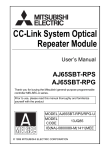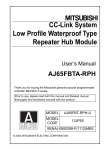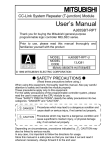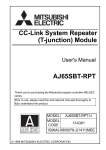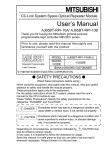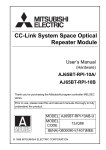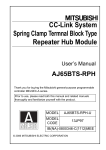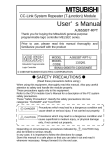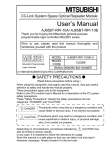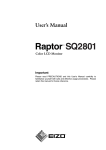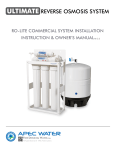Download CC-Link System Optical Repeater Module User`s Manual
Transcript
CC-Link System Optical Repeater Module User’s Manual AJ65SBT-RPS AJ65SBT-RPG Thank you for buying the Mitsubishi general-purpose programmable logic controller MELSEC series. Prior to use, please read this manual thoroughly and familiarize yourself with the product MODEL AJ65SBT-RPS/RPG-U MODEL 13JQ85 CODE IB(NA)-0800089-I(0806)MEE ©1999 MITSUBISHI ELECTRIC CORPORATION z SAFETY PRECAUTIONS z (Read these precautions before using.) When using this equipment, thoroughly read this manual. Also pay careful attention to safety and handle the module properly. The precautions given in this manual are concerned with this product. For the safety precautions of the PLC system, please read the user's manual for the CPU module to use. These "SAFETY PRECAUTIONS " classify the safety precautions into two categories: "DANGER" and "CAUTION". DANGER CAUTION Procedures which may lead to a dangerous condition and cause death or serious injury, if not carried out properly. Procedures which may lead to a dangerous condition and cause superficial to medium injury, or physical damage only, if not carried out properly. CAUTION may also Depending on circumstances, procedures indicated by be linked to serious results. In any case, it is important to follow the directions for usage. Store this manual in a safe place so that you can take it out and read it whenever necessary. Always forward it to the end user. [DESIGN PRECATUIONS] DANGER Input/output could be switched on or off when a problem occurs in the repeater module. So build an external monitoring circuit that will monitor any input/output signals that could cause a serious accident. CAUTION Use the PLC in the environment that meets the general specifications contained in this Manual. Using the PLC outside the range of the general specifications may result in electric shock, fire or malfunction, or may damage or degrade the module. Do not have control cables and communication cables bundled with or placed near by the main circuit and/or power cables. It may cause malfunction due to noise interference. Wire those cables at least 100mm(3.94 inch) away from the main circuit and/or power cables. A-1 [INSTALLATION PRECAUTIONS] CAUTION Do not directly touch the module’s conductive parts or electronic components. Doing so may cause malfunctions or failure of the module. Tighten the module securely using DIN rail or installation screws within the specified torque range. Loose terminal screws may cause falling, short circuit or erroneous operation. If the terminal screws are too tight, it may cause falling or short circuit due to damage of the screws. [WIRING PRECAUTIONS] DANGER Be sure to shut off all phases of the external power supply used by the system before installation or wiring. If the power is not disconnected at all phases an electric shock or product damage may result. CAUTION Always ground the FG terminal to the protective ground conductor. Otherwise there will be an electric shock or misoperation. Be sure to tighten any unused terminal screws within a tightening torque range (42 to 50N·cm). Failure to do so may cause a short circuit due to contact with a solderless terminal. Use applicable solderless terminals and tighten them with the specified torque. If any solderless spade terminal is used, it may be disconnected when the terminal screw comes loose, resulting in failure. Perform correct wiring for the module according to the product's rated voltage and terminal arrangement. Connecting to a power supply different from the rating or mis-wiring may cause fire and/or trouble. Fix terminal screws securely with the specified torque. Loose terminal screws may cause short circuit or malfunction. If the terminal screws are too tight, it may cause falling, short circuit or erroneous operation due to damage of the screws or module. Make sure foreign objects do not get inside the module, such as dirt and wire chips. It may cause fire, trouble or malfunction. Be sure to fix the cables that are connected to the module in place, either by running them through a duct or by using clamps. If the cables are not fixed in one of these ways, dispersion, movement, or careless pulling of the cables may cause damage to the module or cables, or malfunction due to cable contact faults. A-2 [WIRING PRECAUTIONS] CAUTION When removing the cable from the module, do not pull the cable. When removing the cable with a connector, hold the connector on the side that is connected to the module. When removing the cable connected to the terminal block, first loosen the screws on the part that is connected to the terminal block. Pulling the cable that is still connected to the module may cause malfunction or damage to the module or cable. [STARTUP AND MAINTENANCE PRECAUTIONS] DANGER Do not touch terminals when the power is on. It may cause an electric shock or malfunction. CAUTION Never try to disassemble or modify module. It may cause trouble, malfunction, injury or fire. Do not drop or apply any strong impact to the module. Doing so may damage the module. Be sure to shut off all phases of the external power supply used by the system before cleaning or retightening the terminal screws. If you do not switch off the external power supply, it will cause trouble or malfunction of the module. Be sure to fix the wires or cables by ducts or clamps when connecting them to the module. Failure to do so may cause damage of the module or the cables due to accidental pull or unitentional shifting of the cables, or malfunctions due to poor contact of the cable. Do not install the control lines together with the communication cables, or bring them close to each other. Failure to do so may cause malfunctions due to noise. Do not install/remove the terminal block more than 50 times after the first use of the product. (IEC 61131-2 compliant) Before handling the module, always touch grounded metal, etc. to discharge static electricity from the human body. Failure to do so can cause the module to fail or malfunction. [DISPOSAL PRECAUTIONS] CAUTION When disposing of this product, treat it as industrial waste. A-3 REVISIONS The manual number is given on the bottom right of the top cover. Print Date Manual Number Revision Nov., 1999 IB (NA)-0800089-A First edition Jun., 2000 IB (NA)-0800089-B Correction Section 2.2(5) Jan., 2001 Mar., 2005 IB (NA)-0800089-C Correction Section 3.3.2(3) IB (NA)-0800089-D Addition Conformation to the EMC Directive and Low Voltage Instruction Correction SAFETY PRECAUTIONS, About the Manuals, Abbreviated names, generic names and terms, Chapter 1, Section 1.1, 2.1, 2.3, 3.1, 3.2, 3.3.1, 3.3.2, 3.4, 4.1, 4.2.1, 4.2.2, 4.3, 4.4, 4.7, 4.8, Chapter 5, Chapter 6 Mar., 2006 IB (NA)-0800089-E Correction REVISIONS, Conformation to the EMC Directive and Low Voltage Instruction, Section 2.2, 2.3 Sep., 2006 IB (NA)-0800089-F Correction SAFETY PRECAUTIONS Dec., 2006 IB (NA)-0800089-G Correction About the Manuals, Abbreviated names, generic name and terms, Section 2.3, 3.2, 3.3.1, 4.2.1 IB (NA)-0800089-H Correction Jul., 2007 Section 4.3, Chapter 6 Jun., 2008 IB (NA)-0800089-I Correction Compliance with the EMC Directive and the Low Voltage Directive, Chapter 1, Section 2.3, Section 3.2, 3.3.1, 3.4 This manual confers no industrial property rights or any rights of any other kind, nor dose it confer any patent licenses. Mitsubishi Electric Corporation cannot be held responsible for any problems involving industrial property rights which may occur as a result of using the contents noted in this manual. © 1999 MITSUBISHI ELECTRIC CORPORATION A-4 CONTENTS 1. OVERVIEW .................................................................................................. 1 1.1 Features ................................................................................................. 1 2. SYSTEM CONFIGURATION ........................................................................ 3 2.1 Total configuration .................................................................................. 3 2.2 Checking hardware versions................................................................... 4 2.3 Cautions on system configuration ........................................................... 4 3. SPECIFICATIONS...................................................................................... 12 3.1 General specifications........................................................................... 12 3.2 Performance specifications ................................................................... 13 3.3 Specifications of connection cables ...................................................... 14 3.3.1 CC-Link dedicated cable............................................................... 14 3.3.2 Optical fiber cable specifications................................................... 14 3.4 Max. transmission distance................................................................... 15 4. PROCEDURE UP TO START OF DATA LINK ........................................... 16 4.1 Procedure up to start of data link .......................................................... 16 4.2 Mounting and installation ...................................................................... 16 4.2.1 Cautions on handling .................................................................... 16 4.2.2 Installation environment ................................................................ 19 4.3 Names and settings of parts ................................................................. 20 4.4 Check of module state (Hardware test) ................................................. 22 4.5 Setting of switches ................................................................................ 23 4.6 Installation and removal of protective cover .......................................... 24 4.7 Connection of module through cable..................................................... 25 4.8 Check for state of connection (Line test) ............................................... 26 5. TROUBLESHOOTING................................................................................ 28 6. EXTERNAL DIMENSIONS ......................................................................... 33 A-5 About the Manuals The following manuals are related to this product. Referring to this list, please request the necessary manuals. Detailed Manual Manual Number (Model Code) CC-Link System Master/Local Module Type AJ61BT11, IB(NA)-66721 A1SJ61BT11 User's Manual (13J872) CC-Link System Master/Local Module Type IB(NA)-66722 AJ61QBT11, A1SJ61QBT11 User's Manual (13J873) CC-Link System Master/Local Module User's Manual SH(NA)-080394E QJ61BT11N (13JR64) CC-Link System Repeater (T-junction) Module User's IB(NA)-0800078 Manual AJ65SBT-RPT (13JQ81) CC-Link System Space Optical Repeater Module User's IB(NA)-0800090 Manual AJ65BT-RPI-10A/AJ65BT-RPI-10B (13JQ86) CC-Link System Low Profile Waterproof Type Repeater IB(NA)-0800288 Hub Module User’s Manual AJ65FBTA-RPH (13JP55) CC-Link System Spring Clamp Terminal Block Type IB(NA)-0800346 Repeater Hub Module User’s Manual AJ65BTS-RPH (13JP97) Manual Name Compliance with the EMC Directive and the Low Voltage Directive (1) For programmable controller system To configure a system meeting the requirements of the EMC and Low Voltage Directives when incorporating the Mitsubishi programmable controller (EMC and Low Voltage Directives compliant) into other machinery or equipment, refer to the "EMC AND LOW VOLTAGE DIRECTIVES" chapter of the User's Manual for the CPU module used. The CE mark, indicating compliance with the EMC and Low Voltage Directives, is printed on the rating plate of the programmable controller. (2) For the product For the compliance of this product with the EMC and Low Voltage Directives, refer to the "CC-Link module" section in the "EMC AND LOW VOLTAGE DIRECTIVES" chapter of the User's Manual for the CPU module used. A-6 Abbreviated names, generic names and terms Abbreviated names, generic names and terms AJ65SBT-RPS/RPG AJ65SBT-RPT AJ65FBTA-RPH AJ65BTS-RPH AJ65BT-RPI-10A/10B Master station Local station Remote I/O station Remote device station Remote station Intelligent device station Standby master station Master local module Master module Local module Remote module Intelligent device module Segment Repeater Description Abbreviation of AJ65SBT-RPS/AJ65SBT-RPG type CC-Link system optical repeater module. Abbreviation of AJ65SBT-RPT type CC-Link system repeater (T-junction) module. Abbreviation of AJ65FBTA-RPH type CC-Link system low profile waterproof type repeater hub module. Abbreviation of AJ65BTS-RPH type CC-Link system spring clamp terminal block type repeater module. Abbreviation of AJ65BT-RPI-10A/AJ65BT-RPI-10B type CC-Link system space optical repeater module. Station to control the data link system. One station is required for each system. Station which has a sequencer CPU and can communicate with the master station and the other local stations. Remote station processing only information in unit of bit. (AJ65BTB1-16D, AJ65SBTB1-16D, AJ65SBTB1-8 , etc.) Remote station processing only information in unit of bit and in unit of word.(AJ65BT-64AD, AJ65BT-64DAV, AJ65BT-64DAI, etc.) Generic name of remote I/O station and remote device station. Controlled by the master station. Station allowing transient transmission such as AJ65BT-R2N. (Including local stations) Backup station for data link control when the link to the master station is disconnected due to a PLC CPU or power supply problem. Generic name of QJ61BT11N, QJ61BT11, AJ61BT11, A1SJ61BT11, AJ61QBT11 and A1SJ61QBT11. Generic name of QJ61BT11N, QJ61BT11, AJ61BT11, A1SJ61BT11, AJ61QBT11 and A1SJ61QBT11 when these are used as the master station. Generic name of QJ61BT11N, QJ61BT11, AJ61BT11, A1SJ61BT11, AJ61QBT11 and A1SJ61QBT11 when these are used as the local station. Generic name of AJ65BTB1-16D, AJ65SBTB1-16D, AJ65BT-64AD, AJ65BT-64DAV, AJ65BT-64DAI and A852GOT. Module allowing transient transmission such as AJ65BT-R2N. System between terminating resistor connected to each other through cross-over cables. The conventional CC-Link system can be said to be configured with one segment (See Section 2.1.). Module for expanding the CC-Link system by connecting the segments to each other. Product structure The product structure of AJ65SBT-RPS/RPG is given in the table below. Part name AJ65SBT-RPS/RPG module Terminating resistor 110 1/2W (Brown, Brown, Brown) Terminating resistor 130 1/2W (Brown, Orange, Brown) A-7 Quantity 1 1 1 1. OVERVIEW This User's Manual describes the specifications, part names, settings and others of the AJ65SBT-RPS type CC-Link system optical repeater module (for SI/H-PCF/Broad-band H-PCF/QSI optical fiber cables) and the AJ65SBT-RPG type CC-Link system optical repeater module (for GI optical fiber cables) used in the CC-Link system. 1.1 Features The AJ65SBT-RPS/RPG module is used to increase the flexibility of laying the cables of the CC-Link system. Using two the same product of AJ65SBT-RPS/RPG enables a transmission distance increase and T-junction wiring using optical fiber cables in all CC-Link systems. In addition, using optical fiber cables facilitates avoiding the noise trouble of the transmission path, improving system stability. (1) Extended transmission distance in CC-Link system Use of this module increases the transmission distance of the CC-Link system. In addition, use of multiple modules enables the transmission distance to be increased up to 3 stages (up to 2 stages when the AJ65SBT-RPGs are used). Remote station Increased up to 7.8km!! *1 Master station Remote I/O station Repeater *2 *2 *2 1st stage 2nd stage 3rd stage Terminating resistor (required) Optical fiber cable CC-Link dedicated cable *1 The maximum transmission distance on the assumption that the transmission speed setting is 156kbps in a system only the AJ65SBT-RPSs are used as repeaters. *2 Though not shown here, the other remote stations can be connected between the repeaters. (2) Enabled T-junction wiring in CC-Link system Arrangement of these modules between the CC-Link system modules enables the CC-Link system to be wired in the form of T-junction. Master station Repeater Remote I/O station Intelligent device station Remote device station Repeater Remote I/O station Optical fiber cable CC-Link dedicated cable T-junction wiring enabled!! Terminating resistor (required) (3) Noise-resistant stable system Optical fiber cables used for junction and extension make it easy to avoid trouble caused by noise, improving system stability. 1 (4) Mountable to control panel with either screws or DIN rail This module can be mounted onto the control panel with either screws or DIN rail. (5) Compact module size The module size has been reduced to the same one as that of AJ65SBTC4-16 / AJ65SBTC1-32 type small remote I/O module. AJ65SBT-RPS/RPG 2 Item Size Height 50 mm (1.97 inch) Width 118 mm (4.65 inch) Depth 40 mm (1.58 inch) 2. SYSTEM CONFIGURATION 2.1 Total configuration The total configuration employed when the AJ65SBT-RPS/RPG module is used is as shown below. [Segment] Master station*1 Intelligent Repeater Repeater Remote I/O device station (AJ65SBT-RPS/RPG) station (AJ65SBT-RPS/RPG) [Segment (1st stage)] Remote I/O station Remote device station Repeater (AJ65SBT-RPS/RPG) Intelligent Remote device station device station [Segment (1st stage)] Local station Remote I/O station Repeater (AJ65SBT-RPS/RPG) [Segment (2nd stage)] *2 Remote I/O station Remote I/O station Optical fiber cable CC-Link dedicated cable Repeater (AJ65SBT-RPS/RPG) Terminating resistor (required) *1 The transmission speed of each segment must be matched with that of the master station. *2 Up to 3 stages of segments may be used. (Up to 2 stages when the AJ65SBT-RPGs are used) 3 2.2 Checking hardware versions The hardware versions of the AJ65SBT-RPS/RPG can be checked on the DATE section on the rating plate, which is situated on the side on the module. Year and month of manufacture MODEL Hardware version Software version POWER DATE Conformed standard yymm A B MADE IN JAPAN BD992C154H06 2.3 Cautions on system configuration (1) Conditions of usable master module When the AJ61BT11, A1SJ61BT11, AJ61QBT11 and A1SJ61QBT11 modules are used, those of the functional version B or later must be employed. Use the master module bearing the version 9707 B or later in the DATE column of the name plate as shown in the figure below. When the QJ61BT11N, QJ61BT11 module is used, any module can be used irrespective of the version. (a) Rating plate of AJ61BT11 or AJ61QBT11 Year and month of manufacture (Use a master module of 9707 or later.) PROGRAMMABLE CONTROLLER DATE yymm B Function version Conformed standard MADE IN JAPAN BD992C103H06 4 (b) Rating plate of A1SJ61BT11 or A1SJ61QBT11 Year and month of manufacture MODEL Hardware version Software version POWER DATE Conformed standard yymm A B MADE IN JAPAN BD992C154H06 (2) Max. number of modules connected to configure CC-Link system Up to 64 modules of repeaters can be connected in one segment. In the CC-Link system where repeaters are used, also the number of remote stations capable of being controlled by one master station is the same as in the other systems. For details, refer to the User's Manual of the applicable master module. (3) Combination of optical repeater modules and optical fiber cable used Use the optical repeater modules and fiber-optic cable in the following combination. Module AJ65SBT-RPS AJ65SBT-RPG Optical fiber Cable SI type optical fiber cable (max. extension distance of cable: 500m (1639.34ft.)) H-PCF/Broad-band H-PCF/QSI type optical fiber cable (max. extension distance of cable: 1000m (3278.69ft)) GI type optical fiber cable (max. extension distance of cable: 2000m (6557.38ft.)) Example: Combination for use of AJ65SBT-RPG Repeater (AJ65SBT-RPG) Repeater (AJ65SBT-RPG) GI type Optical fiber cable 5 (4) Max. number of stages connected to configure segment Use of the AJ65SBT-RPS enables communication between the master station and a remote station located up to three segments away from the master station segment, and use of the AJ65SBT-RPG enables communication between the master station and a remote station located up to two segments away from the master station segment. If the system includes both the AJ65SBT-RPS and AJ65SBT-RPG, however, up to two stages can be placed. [System using AJ65SBT-RPGs only, or including both AJ65SBT-RPS and AJ65SBT-RPG] [System using only AJ65SBT-RPSs] Master station Master station Segment Segment Segment (1st stage) Repeaters Segment (1st stage) Repeaters Segment(2ndstage) Remote station Remote station Segment(3rd stage) 6 Segment(2ndstage) (5) Instructions for using different models of repeaters in combination Note that when combining the repeaters of different models, there are the following restrictions on the number of connectable repeaters and the number of connected stages. Max. number of repeaters Combination pattern AJ65BTS AJ65FBT AJ65SBT AJ65SBT AJ65SBT AJ65BT -RPI -RPH A-RPH -RPH -RPS -RPG 1 — 2 — — — — 1 2 — — — 1 — — 2(1set) — — 1 — — — 2(1 set) — — 1 — 2(1 set) — — — 1 — — 2(1 set) — 1 — — — — 2(1 set) — 1 — — — 2(1 set) 4) — — 2 4(2 set) — — 5) — — 2 — 2(1 set) — 6) — — 2 — — 2(1 set) 7) — — — 2(1 set) 2(1 set) — — — — 2(1 set) — 2(1 set) — — — — 2(1 set) 2(1 set) 1 1 — — — — 1) 2) 3) 8) 9) 7 -10A/10B Max. number of stages 3 2 4 3 2 POINT • For the CC-Link system, up to 2 repeater types can be used in combination. Using 3 models or more is not allowed. • When repeaters are connected in the same segment by link wiring, up to 64 modules can be connected. For details, refer to the user's manual of the master module used. Ex.) A CC-Link system with combination pattern 7) is built Master station Segment AJ65FBTA-RPH Up to 64 modules can be connected in a segment. AJ65BT-RPI Segment 1st stage Segment AJ65BT-RPI 2nd stage Remote station Segment 3rd stage For combination pattern 7), 4 (2 sets) or more AJ65BT-RPIs are not connectable. 8 (a) Combination pattern 1) (c) Combination pattern 3) Master station Master station Segment Segment AJ65BTS-RPH or AJ65FBTA-RPH One module AJ65BTS-RPH or AJ65FBTA-RPH One module Segment 1st stage IN Segment 1st stage OUT AJ65SBT-RPT Up to two modules AJ65BT-RPI Two modules (one set) Segment 2nd stage IN OUT Remote station Segment 2nd stage Segment 3rd stage Remote station (b) Combination pattern 2) (d) Combination pattern 4) Master station Master station Segment Segment AJ65BTS-RPH or AJ65FBTA-RPH One module IN OUT AJ65SBT-RPT Up to two modules Segment 1st stage AJ65SBT-RPS or AJ65SBT-RPG Two modules (one set) Segment 1st stage IN OUT Segment 2nd stage Segment 2nd stage AJ65SBT-RPS Four modules (two sets) or Two modules (one set) Remote station Segment 3rd stage Segment 4th stage Remote station 9 (e) Combination pattern 5) (g) Combination pattern 7) Master station Master station Segment Segment IN OUT AJ65SBT-RPT Up to two modules AJ65SBT-RPS Two modules (one set) Segment 1st stage IN OUT Segment 1st stage Segment 2nd stage AJ65SBT-RPG Two modules (one set) AJ65SBT-RPG Two modules (one set) Segment 3rd stage Segment 2nd stage Remote station Remote station (f) Combination pattern 6) (h) Combination pattern 8) Master station Master station Segment Segment IN AJ65SBT-RPS or AJ65SBT-RPG Two modules (one set) OUT AJ65SBT-RPT Up to two modules Segment 1st stage IN OUT Segment 1st stage Segment 2nd stage AJ65BT-RPI Two modules (one set) AJ65BT-RPI Two modules (one set) Segment 3rd stage Segment 2nd stage Remote station Remote station 10 (i) Combination pattern 9) Master station Segment AJ65BTS-RPH One module Segment 1st stage AJ65FBTA-RPH One module Segment 2nd stage Remote station 11 3. SPECIFICATIONS 3.1 General specifications The general specifications of the AJ65SBT-RPS/RPG are shown below. Item Operating ambient temperature Storage ambient temperature Operating ambient humidity Storage ambient humidity Specifications 0 to 55 -20 to 75 Shock resistance Operating environment Operating height *3 Installation area Over-voltage category *1 Pollution rate *2 C 10 to 90 % RH, No condensation 10 to 90 % RH, No condensation Frequency Conforming to JIS B Vibration resistance 3502, IEC 61132-2 C Acceleration Amplitude Sweep Count When there 10 to 57 Hz — 0.075 mm 10 times is intermittent — 57 to 150 Hz 9.8 m/s2 each in X, Y vibration When there 10 to 57 Hz — 0.035 mm and Z axis (80 minutes) is continuous — 57 to 150 Hz 4.9 m/s2 vibration Conforming to JIS B 3502, IEC 61131-2 (147 m/s2, 3 times each in 3 directions X, Y, Z) No corrosive gas present 2000 m (6562 ft) or less On the control board *4 II or less 2 or less *1 Indicates the location where the device is connected from the public cable network to the device structure wiring area. Category II applies to the devices to which the power is supplied from a fixed equipment. Surge withstand voltage for devices with up to 300 V of rated voltage is 2500 V. *2 This is an index which indicates the degree of conductive object generation in the environment Pollution level 2 is when only non-conductive pollution occurs. A temporary conductivity caused by condensation must be expected occasionally. *3 Do not use or store the PC in the environment where the pressure is higher than the atmospheric pressure at sea level. Otherwise, malfunction may result. To use the PC in high-pressure environment, contact your nearest Mitsubishi representative. *4 It can also be used in an environment other than on the control panel if the conditions such as usage ambient temperature and humidity are satisfied. 12 3.2 Performance specifications The performance specifications of the AJ65SBT-RPS/RPG are shown below. Specifications Item AJ65SBT-RPS Power supply Voltage 20.4 to 26.4 VDC Current 0.06mA (at TYP. 24VDC) Noise immunity Dielectric withstand voltage Simulator noise of 500Vp-p, obtained by a noise simulator of 1 s noise width and 25 to 60Hz noise frequency 500VAC for 1 minute between all DC external terminals and ground 10M Insulation resistance Common specifications AJ65SBT-RPG or higher, measured with a 500VDC insulation resistance tester Weight 0.2kg Communication 7-point 2-piece terminal block External area, [transmission circuit, module power supply, FG] connection module power M3 supply Applicable solderless terminals: 2 max. 5.2 Tightening torque: 59 to 88N·cm · RAV1.25-3 (conforming to JIS C 2805) 2 Applicable solderless terminals [Applicable wire size :0.3 to 1.25mm ] · V2-MS3, RAP2-3SL, TGV2-3N 2 [Applicable wire size: 1.25 to 2.0mm ] Selectable from among 156kbps, 625kbps, Transmission speed 2.5Mbps, 5Mbps and 10Mbps AJ65SBT-RPS only (Refer to Section 2.3(4)) 3 stages AJ65SBT-RPG only (Refer to Section 2.3(4)) 2 stages · Combination of AJ65SBT-RPS and AJ65SBT-RPG · Combination of Max. number of stages CC-Link connected to configure segment 2 stages AJ65SBT-RPG/AJ65SBT-RPS and one of AJ65FBTA-RPH, AJ65BTS-RPH, or AJ65BT-RPI. (Refer to Section 2.3(5)) communication specifications Combination of AJ65SBT-RPS and 4 stages AJ65SBT-RPT (Refer to Section 2.3(5)) Combination of AJ65SBT-RPG and 3 stages AJ65SBT-RPT (Refer to Section 2.3(5)) Max. transmission distance of Varies according to transmission speed. each segment Max. number of modules (Refer to Section 3.4) 64 (Refer to Section 2.3 for the conditions for the number of connected modules connected) Number of stations occupied 0 (none) Settable station number Connection cable Optical Applicable connector communication Max. transmission distance of specifications optical fiber cable between No station numbers SI-200/220 QSI-185/230 GI-50/125 CA7003 CA9103S 500m (1639.34ft.) 1000m (3278.69ft.) 2000m (6557.38ft.) repeaters 13 3.3 Specifications of connection cables 3.3.1 CC-Link dedicated cable Use the CC-Link dedicated cable for the CC-Link system. If a cable other than the CC-Link dedicated cable is used, the performance of the CC-Link system cannot be guaranteed. For the specifications of the CC-Link dedicated cables or any other inquiries, visit the following site: CC-Link Partner Association website: http://www.cc-link.org/ REMARK For details, refer to the CC-Link cable wiring manual issued by the CC-Link Partner Association. 3.3.2 Optical fiber cable specifications For details of the AJ65FBTA-RPH, AJSBT-RPT and/or AJ65BT-RPI-10A/-10B, refer to the respective user’s manual. Confirm the details of the optical fiber specifications by the cable that is being used. The optical fiber cables and connectors are dedicated parts. Optical fiber cable with connectors are sold by Mitsubishi System Service. (A catalogue of optical fiber cables is available.) Mitsubishi System Service can also provide installation. Contact your nearest representative for details. Item Max. transmission distance Transmission loss Core diameter Clad diameter Primary membrane Applicable connector SI (Multi-particulate glass) H-PCF Broad-band H-PCF QSI GI-50/125 (Plastic-clad) (Plastic-clad) (Quartz glass) (Quartz glass) 500 m 1 km 1 km 1 km 2 km 12 dB/km 6 dB/km 5 dB/km 5.5 dB/km 3 dB/km 200 m 200 m 200 m 185 m 50 m 220 m 250 m 250 m 230 m 125 m 250 m — — 250 m — F06/F08 or equivalent (JIS C 5975/5977 conformance) REMARK Prepare the following types of optical cables. A type: Cable for connection inside control panel. B type: Cable for connections between outside control panels. C type: Cable for outdoor connections. D type: Cable for outdoor connections that have been reinforced. There are special cables available for moveable applications and resistance to heat. Contact your Mitsubishi System Service for details. 14 3.4 Max. transmission distance [System using only AJ65SBT-RPSs] Transmission speed set to 156kbps Master station [System using AJ65SBT-RPGs only, or including both AJ65SBT-RPS and AJ65SBT-RPG] Transmission speed set to 156kbps Master station Segment Max. 1200m (3934.43ft.) Fiber-optic cable Max. 1000m (3278.69ft.) Segment (1st stage) Max. 1200m Max. Repeaters (3934.43ft.) transmission Fiber-optic cable distance Max. 1000m (3278.69ft.) 7.8km Segment(2ndstage) (25573.77ft.) Max.1200m Remote (3934.43ft.) station Fiber-optic cable Max. 1000m (3278.69ft.) Segment(3rd stage) Max. 1200m (3934.43ft.) Repeaters Remote station Segment Max. 1200m (3934.43ft.) Fiber-optic cable Max. Max. 2000m transmission (6557.38ft.) Segment (1st stage) distance Max. 1200m (3934.43ft.) 7.6km Fiber-optic cable (24918.03ft.) Max. 2000m (6557.38ft.) Segment(2ndstage) Max.1200m (3934.43ft.) *When H-PCF/Broad-band H-PCF/QSI type optical fiber cables are used Conditions Transmission speed Description The maximum transmission distance in each segment is the same as that in normal CC-Link system (system configured with one segment only). The maximum transmission distance in each segment varies according to the transmission speed. For details, refer to the User's Manual of the applicable master module. (The length of the cables between repeater stations is treated in the same manner as in the remote I/O station.) Max. number of stages When one connection stage is added, the maximum transmission distance connected to configure is added by an amount equivalent to one segment. segment 15 4. PROCEDURE UP TO START OF DATA LINK 4.1 Procedure up to start of data link The procedure ranging from the installation of the AJ65SBT-RPS/RPG module to the start of data link is described below. Start Install the AJ65SBT-RPS/RPG module. Refer to Section 4.2. Check for the conditions of the AJ65SBT -RPS/RPG module (hardware test). Refer to Section 4.4. Set the switches of the module. Refer to Section 4.5. Connect the modules using CC-Link dedicated cables and optical fiber cables. Refer to Section 4.7. Check for the connection conditions of the modules (line test). Refer to Section 4.8. Start the system. Refer to the User's Manual of the applicable master module. Completion POINT The procedure described here is for the AJ65SBT-RPS/RPG module only. In order for you to understand the procedure of the entire CC-Link system, refer to the User's Manual of the applicable master module. 4.2 Mounting and installation 4.2.1 Cautions on handling Cautions on handling the AJ65SBT-RPS/RPG module are described below. DANGER Be sure to shut off all phases of the external power supply used by the system before installation or wiring. If the power is not disconnected at all phases an electric shock or product damage may result. Do not touch terminals when the power is on. It may cause an electric shock or malfunction. 16 CAUTION Do not have control cables and communication cables bundled with or placed near by the main circuit and/or power cables. It may cause malfunction due to noise interference. Wire those cables at least 100mm(3.94 inch) away from the main circuit and/or power cables. Do not directly touch the module’s conductive parts or electronic components. Doing so may cause malfunctions or failure of the module. Tighten the module securely using DIN rail or installation screws within the specified torque range. Loose terminal screws may cause falling, short circuit or erroneous operation. If the terminal screws are too tight, it may cause falling or short circuit due to damage of the screws. Fix terminal screws securely with the specified torque. Loose terminal screws may cause short circuit or erroneous operation. If the terminal screws are too tight, it may cause falling, short circuit or erroneous operation due to damage of the screws or module. Always ground the FG terminal to the protective ground conductor. Otherwise there will be an electric shock or misoperation. Be sure to tighten any unused terminal screws within a tightening torque range (42 to 50N·cm). Failure to do so may cause a short circuit due to contact with a solderless terminal. Use applicable solderless terminals and tighten them with the specified torque. If any solderless spade terminal is used, it may be disconnected when the terminal screw comes loose, resulting in failure. Perform correct wiring for the module according to the product's rated voltage and terminal arrangement. Connecting to a power supply different from the rating or mis-wiring may cause fire and/or trouble. Make sure foreign objects do not get inside the module, such as dirt and wire chips. It may cause fire, trouble or malfunction. Be sure to fix the wires or cables by ducts or clamps when connecting them to the module. Failure to do so may cause damage of the module or the cables due to accidental pull or unitentional shifting of the cables, or malfunctions due to poor contact of the cable. Do not install the control lines together with the communication cables, or bring them close to each other. Failure to do so may cause malfunctions due to noise. When removing the cable from the module, do not pull the cable. When removing the cable with a connector, hold the connector on the side that is connected to the module. When removing the cable connected to the terminal block, first loosen the screws on the part that is connected to the terminal block. Pulling the cable that is still connected to the module may cause malfunction or damage to the module or cable. Never try to disassemble or modify the module. It may cause trouble, malfunction, injury or fire. Do not drop or apply any strong impact to the module. Doing so may damage the module. 17 CAUTION Be sure to shut off all phases of the external power supply used by the system before mounting or dismounting the module to or from the panel. If you do not switch off the external power supply, it will cause trouble or malfunction of the module. Be sure to shut off all phases of the external power supply used by the system before cleaning or retightening the terminal screws. If you do not switch off the external power supply, it will cause trouble or malfunction of the module. Do not install/remove the terminal block more than 50 times after the first use of the product. (IEC 61131-2 compliant) Before handling the module, always touch grounded metal, etc. to discharge static electricity from the human body. Failure to do so can cause the module to fail or malfunction. When disposing of this product, treat it as industrial waste. (1) Tighten the module fixing screws and terminal block screws to those torques specified below. Do not over-tighten these screws. The screws and module case may be damaged. Screw location Module fixing screw (M4 thread with finished circular flat washer) Terminal block screw (M3 thread) Terminal block mounting screw (M3.5 thread) Specified torque range 78 to 108 N • cm 59 to 88 N • cm 68 to 98 N • cm (2) A protective film is attached on the module's surface for the purpose of scratch prevention during transportation. Prior to use, be sure to remove it. (3) When a DIN rail is used, install it taking care with the following. (a) Applicable DIN rail type (conforming to IEC 60715) TH35-7.5Fe TH35-7.5A1 (b) Intervals of DIN rail mounting screws Mount the DIN rail by fixing it with mounting screws at intervals of 200 mm (7.87inch) or shorter. (4) To install the AJ65SBT-RPS/RPG module on the DIN rail, press, by the finger, the DIN rail hook located on the underside of the module at the centerline until you hear it click. DIN rail DIN rail hook 18 (5) When installing the AJ65SBT-RPS/RPG module on the control panel, to improve the ventilation and facilitate the replacement of the module, provide a distance of 60 mm (2.36inch) or longer between the upper and lower surfaces of the module and the structural members or parts. (6) Install the AJ65SBT-RPS/RPG module on a flat smooth surface. If there are irregularities on the installation surface, undue force may be applied to the printed circuit boards, and the boards may be damaged. (7) Depending on the grounding condition of the system, a high-frequency noise may occur between the systems. When these systems are connected through CC-Link dedicated cables, a communication error may occur by the mixing of noise into the repeaters. If the high-frequency noise occurs between the systems connected through the cables of 10 m (32.79ft.) or shorter, take the measure which uses CC-Link cables of 10 m (32.79ft.) or longer between the systems. [System 1] [System 2 (Control panel which may produce noise)] Repeater Remote station (AJ65SBT-RPS/RPG) Remote station 10 m (37.79ft.) or shorter Method : Use the cables of 10 m (37.79ft.)or longer. 4.2.2 Installation environment For the installation environment, refer to section 3.1. 19 Source of high-frequency noise (servo, inverter) 4.3 Names and settings of parts The names of parts of the AJ65SBT-RPS/RPG module, indication statuses of LEDs, and settings of switches are described below. The following shows the AJ65SBT-RPS. The LED indications and switch settings are the same as those for the AJ65SBT-RPG. The figure shown below is a module of hardware version D or later. Modules of hardware version C or earlier have different appearance although the LED indications and switch settings are the same as those of hardware version D or later. For the appearance of the hardware version C or earlier, refer to Chapter 6 (2). 1) 3) 2) PW TEST ERR. SD RD SD TWI. B RATE TEST 4 2 1 RD ON OPT. AJ65SBT-RPS DA DG DB SLD 24G (FG) OUT 4) 6) 20 IN 5) No. Name 1) Power LED 2) Transmission speed setting switch 3) Test switch 4) Terminal block Optical 5) interface Hook for DIN 6) rail Application Check for the module condition by observing the state of lighting of the LED. LED Application Name For hardware test For normal operation Goes on: At power-on. PW Goes off: At power-off. Goes on: Hardware test is under operation. TEST Goes off: Communication is under operation. Goes on: Hardware is faulty. Goes on: Communication is faulty. Switch set value is Switch set value is faulty. faulty. Flashes: Switch set value was ERR. Flashes: Switch set value was changed during operation. changed during Goes off: Communication is normal. operation. Goes off: Normal Flashes: Circuit is normal. Goes on: Data is being transmitted to Goes off: Circuit is faulty. CC-Link side. SD1 Goes off: Data is not transmitted to CC-Link side. Flashes: CC-Link side circuit is Goes on: Data is being received from normal. CC-Link side. RD1 Goes off: Optical communication Goes off: Data is not received from side circuit is faulty. CC-Link side. Flashes: Circuit is normal. Goes on: Data is being transmitted to Goes off: Circuit is faulty. optical communication side. SD2 Goes off: Data is not transmitted to optical communication side. Flashes: CC-Link side circuit is Goes on: Data is being received from normal. optical communication side. RD2 Goes off: Optical communication Goes off: Data is not received from side circuit is faulty. optical communication side. Set the transmission speed of the module (set to 0 at the time of delivery). Setting Setting switch status Transmission value speed 4 2 1 0 OFF OFF OFF 156kbps 1 OFF OFF ON 625kbps 2 OFF ON OFF 2.5Mbps 3 OFF ON ON 5Mbps 4 ON OFF OFF 10Mbps Cannot be set. 5 to 7 If set to 5 to 7, the ERR. LED is turned on and data are not transferred. Set the operating condition of the module (set to OFF at the time of delivery). State of switch Operating state ON Hardware test OFF Normal operation Terminal block for connecting the power supply and CC-Link dedicated cables. Terminal block for connecting the CC-Link dedicated cable on the side where the master station is not located. Hook for installing the module on the DIN rail. To install the module, press the DIN rail hook at the centerline until you hear it click. POINT The setting of the test switch is made valid when the module power is turned from OFF to ON. If the setting is changed with the module power ON, perform the above operation again. 21 4.4 Check of module state (Hardware test) Check that the module operates normally using the module proper. Ensure to perform this check before configuring the system. A hardware test requires the following type of testing optical cable. Obtain this optional testing optical cable from your nearest Mitsubishi representative. Item Type Testing optical cable Description Remarks Optical cable for loopback self-test for CC-Link AN-CCLT Optional system optical repeater module (0.5m (1.64ft.)) Perform the test in accordance with the steps shown below. Start A hardware test requires the following type of testing optical cable. Connect only the power supply cable to the terminal block. ................... Refer to Section 4.3. Set the test switch to ON (Hardware Test). ................... Refer to Section 4.3. After checking the input power supply voltage, turn on the power supply. Does PW LED light up? NO Check that the power supply is Normal normal and the power supply cable is connected correctly. NO Check that the test switch is set to ON. NO Check that the transmission speed is Normal set correctly. YES Does TEST LED light up? Normal YES Does ERR. LED go off? YES Shut off the power supply. Completion The hardware may have a defect. Contact the nearest sales office, and explain the error symptom and get advice. 22 4.5 Setting of switches The setting of the switches on the AJ65SBT-RPS/RPG module is described below. (1) Test switch This switch is used to set the operating condition of the AJ65SBT-RPS/RPG module. In normal operation, set it to OFF. For detail of the setting, refer to Section 4.3. POINT The setting of the test switch is made valid when the module power is turned from OFF to ON. If the setting is changed with the module power ON, perform the above operation again. (2) Transmission speed setting switch This switch is used to set the transmission speed of the AJ65SBT-RPS/RPG module. For detail of the setting, refer to Section 4.3. POINT • Set to the same state of setting as set in the master station. • The setting of the transmission speed setting switches is made valid when the module power is turned from OFF to ON. If the setting is changed with the module power ON, perform the above operation again. 23 4.6 Installation and removal of protective cover A protective cover can be installed on the front surface of the AJ65SBT-RPS/RPG module to prevent foreign matter from entering the terminal blocks. The protective cover applicable to the AJ65SBT-RPS/RPG module is specified below. Procure it as necessary. Item Type Protective cover A6CVR-8 Description Cover for prevention of entry of foreign matter into terminal blocks (sold in batches of 10). Remarks Optional To dismount and mount the protective cover on and from the AJ65SBT-RPS/RPG module, follow the steps below. (1) Mounting With the upper section of the protective cover hooked to the upper end section of the module, press the lower section of the cover until you hear it click. Click (2) Dismounting With the finger applied to the lower section of the protective cover, raise the cover upward. 24 4.7 Connection of module through cable The method of connecting the AJ65SBT-RPS/RPG module to the CC-Link system through the cable is shown below. Master module Terminating resistor DA DB DG SLD FG AJ65SBT-RPS/RPG Remote module DA DA DB DB DG DG (Blue) (White) (Yellow) CC-Link dedicated cable SLD CC-Link dedicated cable FG Terminating resistor SLD FG Optical interface Optical fiber cable Terminating resistor Optical interface DA DA DB DB DG DG SLD FG CC-Link dedicated cable AJ65SBT-RPS/RPG Terminating resistor SLD FG Local module Important In each segment, ensure to use the same type of CC-Link dedicated cables. If different types of cables are used, normal data transmission will not be assured. POINT • Ensure to connect the terminating resistor to both end modules of each segment. In addition, connect them between DA and. (The terminating resistor are furnished with the module.) • The terminating resistor vary according to the type of cables in use. For detail, refer to the User's Manual of the applicable master module. • Connect the shielded wire of the CC-Link dedicated cable to "SLD" of each module, and ground both ends of the shielded wire via "FG". The SLD and FG are connected within the module. 25 4.8 Check for state of connection (Line test) Connect all modules including the AJ65SBT-RPS/RPG module through the CC-Link dedicated cable. Then, check that the CC-Link system is in the state capable of performing a data link normally. Because whether or not a master station can establish a data link with a particular slave station can be checked by the connection status check (circuit test), an error module can be identified. For the connection status check (circuit test), perform the circuit test 1 of the master module. If an error is detected, perform the circuit test 2 of the master module. For the details of circuit tests 1 and 2, refer to the user's manual of the master module used. Perform the test following the steps on the next page. POINT Perform the circuit test 2 of the master module by selecting the target stations as described in (1) to (3) below. (1) In the segment including the master module, select slave stations in order from the nearest to the master module to the farthest. (2) In the segment (1st stage), select slave stations in order from the nearest to the AJ65SBT-RPS/RPG to the farthest. (3) In the segment (2nd stage), select slave stations in order from the nearest to the AJ65SBT-RPS/RPG to the farthest. 26 Start Set the test switch to OFF (normal operation). After checking the input power supply voltage, turn on the power supply. Perform the line test 2 of the master module. In this test, use any one station connected to the downstream side of the AJ65SBT-RPS/RPG (side where the master station does not exist). YES ................... Refer to the User's Manual of the applicable master module. Refer to chapter 5 (1) to perform troubleshooting. Does the master module complete the line test 2 normally? NO Does PW LED light up? NO Refer to chapter 5 (2) to perform troubleshooting. Normal YES Does ERR. LED go off? NO Refer to chapter 5 (3) to perform troubleshooting. Normal Refer to chapter 5 (4) to perform troubleshooting. Normal YES Do TWI.RD and OPT.SD LED light up? NO YES Do OPT.RD and TWI.SD LED light up? YES Completion NO Perform the hardware test (See Section 4.4.) to check that the state of the AJ65SBT-RPS/RPG module is normal. Check that the other stations are normal. Check the combination of the maximum transmission distance, setting of transmission speed, and station-to-station cables. 27 5. TROUBLESHOOTING This section describes the measures when a trouble occurred in the AJ65SBT-RPS/RPG. Perform the troubleshooting indicated in the reference section. This chapter (3), (4) are based on Fig. 5.1. AJ65SBT-RPS/RPG Remote Master station (master station I/O station side) Intelligent device station Remote device station AJ65SBT-RPS/RPG (remote station side) Remote I/O station Optical fiber cable CC-Link dedicated cable Terminating resistor (requited) Figure 5.1 No. *1 Problem 1 The PW LED is not lit while the module power is ON. 2 The ERR. LED lighted up or blinked. The TWI.RD or OPT.SD LED on the master station 3 side is not lit during data link. The OPT.RD or TWI.SD LED on the master station 4 side is not lit during data link. Reference section (1) in this chapter (2) in this chapter (3) in this chapter (4) in this chapter *1 If more than one problem occurred simultaneously, perform the troubleshooting in order of the item numbers. 28 (1) The PW LED is not lit while the module power is ON Troubleshooting is shown below for the case that the PW LED is not lit while the module power is ON. The PW LED does not light up Was the module power turned on? NO Turn on the module power. YES Is the power cable connected correctly? (Refer to Section 4.3) YES Is power supply voltage correct? (Refer to Section 3.2) YES The hardware may have a defect. Contact your local Mitsubishi representative, explaining a detailed description of the problem. NO Connect the power cable correctly. (Refer to Section 4.3) NO Correct the power supply voltage. (Refer to Section 3.2) Completion 29 (2) The ERR. LED lights up or blinks Troubleshooting is shown below for the case that the ERR. LED lights up or blinks. The ERR. LED lights up or blinks. Is the transmission rate of AJ65SBT-RPS/RPG set in the valid range? (Refer to Section 4.3) YES Is the connection of the CC-Link dedicated cable and terminating resistor correct? (Refer to Section 4.7) YES Is there any noise source around the AJ65SBT-RPS/RPG or CC-Link dedicated cable? NO Correct the transmission rate setting of AJ65SBT-RPS/RPG. (Refer to Section 4.3) NO Connect the CC-Link dedicated cable and terminating resistor correctly. (Refer to Section 4.7) NO Move the noise source away from the AJ65SBT-RPS/RPG and CC-Link dedicated cable to a place not influenced by noise. YES Refer to (3) and (4) in this chapter to perform troubleshooting. Completion 30 (3) The TWI.RD or OPT.SD LED on the master station side is not lit during data link The following shows the troubleshooting process for the case where the TWI.RD or OPT.SD LED on the master station side is not lit during data link. The descriptions are based on Fig. 5.1. The TWI.RD or OPT. SD LED on the master station side is not lit. Is the transmission rate setting identical between AJ65SBT-RPS/RPG and the master station? (Refer to Section 4.3) YES Is the CC-Link dedicated cable connected correctly? (Refer to Section 4.7) YES Is there any noise source around the AJ65SBT-RPS/RPG CC-Link dedicated cable? YES NO Correct the transmission rate setting of AJ65SBT-RPS/RPG to the same as the master station. (Refer to Section 4.3) NO Connect the CC-Link dedicated cable correctly. (Refer to Section 4.7) NO Move the noise source away from the AJ65SBT-RPS/RPG and communication cable to a place not influenced by noise. The hardware may have a defect. Contact your local Mitsubishi representative, explaining a detailed description of the problem. Completion 31 (4) The OPT.RD or TWI.SD LED on the master station side is not lit during data link The following shows the troubleshooting process for the case where the OPT.RD or TWI.SD LED on the master station side is not lit during data link. The descriptions are based on Fig. 5.1. The OPT.RD or TWI. SD LED on the master station side is not lit. Is the transmission rate setting identical between AJ65SBT-RPS/RPG and the remote station? (Refer to Section 4.3) YES Is the setting of destination remote station set on the master station correct? YES Is the CC-Link dedicated cable connected to the optical fiber cable correctly? (Refer to Section 4.7) YES Is there any error on the remote station? YES Is there any noise source around the AJ65SBT-RPS/RPG or CC-link dedicated cable? YES NO Correct the transmission rate setting of the remote station to the same as AJ65SBT-RPS/RPG. (Refer to Section 4.3) NO Correct the setting of the destination remote station set on the master station. NO Connect the CC-Link dedicated cable to the optical fiber cable correctly. (Refer to Section 4.7) NO Restore the faulty area referring to the manual of the remote station. NO Move the noise source away from the AJ65SBT-RPS/RPG and CC-Link dedicated cable to a place not influenced by noise. The hardware may have a defect. Contact your local Mitsubishi representative, explaining a detailed description of the problem. Completion 32 6. EXTERNAL DIMENSIONS The external dimensions of the AJ65SBT-RPS/RPG module is shown below. The appearance of the AJ65SBT-RPS/RPG varies depending on the hardware version. For checking method of the hardware version, refer to Section 2.2. 40(1.57) (1) Hardware version D or later The following is the AJ65SBT-RPS. The same dimensions apply to the AJ65SBT-RPG. 118(4.65) 109 +1 0 (4.29 +0.04 0 ) TWI. B RATE TEST 4 2 1 RD OPT. ON 24G (FG) 05 DA DG DB SLD t1 AJ65SBT-RPS 7.5(0.30) RD SD ou 50(1.97) PW TEST ERR. SD Ab 16.5 (0.65) 2-4.5 5.1 Mounting hole (M4 fixing screw) DIN rail center 7.9(0.31) IN 4(0.16) OUT Unit:mm (inch) 33 20(0.79) 118(4.65) 109 +10 (4.29 +0.04 ) 0 50(1.97) 5.1 Mounting hole (M4 fixing screw) PW 4 2 1 ON DA DB DG +24V SLD 24G 7.5(0.30) 16.5 (0.65) 2-4.5 11(0.43) 40(1.57) (2) Hardware version C or earlier The following is the AJ65SBT-RPS. The same dimensions apply to the AJ65SBT-RPG. DIN rail center 7.9(0.31) (FG) IN 4(0.16) OUT Unit : mm (inch) 34 Warranty Mitsubishi will not be held liable for damage caused by factors found not to be the cause of Mitsubishi; machine damage or lost profits caused by faults in the Mitsubishi products; damage, secondary damage, accident compensation caused by special factors unpredictable by Mitsubishi; damages to products other than Mitsubishi products; and to other duties. For safe use y This product has been manufactured as a general-purpose part for general industries, and has not been designed or manufactured to be incorporated in a device or system used in purposes related to human life. y Before using the product for special purposes such as nuclear power, electric power, aerospace, medicine or passenger movement vehicles, consult with Mitsubishi. y This product has been manufactured under strict quality control. However, when installing the product where major accidents or losses could occur if the product fails, install appropriate backup or failsafe functions in the system. Country/Region Sales office/Tel Country/Region Sales office/Tel U.S.A Mitsubishi Electric Automation Inc. Hong Kong Mitsubishi Electric Automation (Hong Kong) Ltd. 500 Corporate Woods Parkway Vernon 10th Floor, Manulife Tower, 169 Electric Hills, IL 60061, U.S.A. Road, North Point, Hong Kong Tel : +1-847-478-2100 Tel : +852-2887-8870 Brazil MELCO-TEC Rep. Com.e Assessoria China Mitsubishi Electric Automation Tecnica Ltda. (Shanghai) Ltd. Rua Correia Dias, 184, 4/F Zhi Fu Plazz, No.80 Xin Chang Road, Edificio Paraiso Trade Center-8 andar Shanghai 200003, China Paraiso, Sao Paulo, SP Brazil Tel : +86-21-6120-0808 Tel : +55-11-5908-8331 Taiwan Setsuyo Enterprise Co., Ltd. Germany Mitsubishi Electric Europe B.V. German 6F No.105 Wu-Kung 3rd.Rd, Wu-Ku Branch Hsiang, Taipei Hsine, Taiwan Gothaer Strasse 8 D-40880 Ratingen, Tel : +886-2-2299-2499 GERMANY Korea Mitsubishi Electric Automation Korea Co., Ltd. Tel : +49-2102-486-0 1480-6, Gayang-dong, Gangseo-ku U.K Mitsubishi Electric Europe B.V. UK Seoul 157-200, Korea Branch Tel : +82-2-3660-9552 Travellers Lane, Hatfield, Hertfordshire., Singapore Mitsubishi Electric Asia Pte, Ltd. AL10 8XB, U.K. 307 Alexandra Road #05-01/02, Tel : +44-1707-276100 Mitsubishi Electric Building, Italy Mitsubishi Electric Europe B.V. Italian Singapore 159943 Branch Tel : +65-6470-2460 Centro Dir. Colleoni, Pal. Perseo-Ingr.2 Thailand Mitsubishi Electric Automation (Thailand) Via Paracelso 12, I-20041 Agrate Brianza., Co., Ltd. Milano, Italy Bang-Chan Industrial Estate No.111 Tel : +39-039-60531 Moo 4, Serithai Rd, T.Kannayao, Spain Mitsubishi Electric Europe B.V. Spanish A.Kannayao, Bangkok 10230 Thailand Branch Tel : +66-2-517-1326 Indonesia P.T. Autoteknindo Sumber Makmur Carretera de Rubi 76-80, Muara Karang Selatan, Block A/Utara E-08190 Sant Cugat del Valles, No.1 Kav. No.11 Kawasan Industri Barcelona, Spain Pergudangan Jakarta - Utara 14440, Tel : +34-93-565-3131 P.O.Box 5045 Jakarta, 11050 Indonesia France Mitsubishi Electric Europe B.V. French Tel : +62-21-6630833 Branch India Messung Systems Pvt, Ltd. 25, Boulevard des Bouvets, F-92741 Electronic Sadan NO:III Unit No15, Nanterre Cedex, France M.I.D.C Bhosari, Pune-411026, India TEL: +33-1-5568-5568 Tel : +91-20-2712-3130 South Africa Circuit Breaker Industries Ltd. Australia Mitsubishi Electric Australia Pty. Ltd. Private Bag 2016, ZA-1600 Isando, 348 Victoria Road, Rydalmere, South Africa N.S.W 2116, Australia Tel : +27-11-928-2000 Tel : +61-2-9684-7777 HEAD OFFICE : TOKYO BUILDING, 2-7-3 MARUNOUCHI, CHIYODA-KU, TOKYO 100-8310, JAPAN NAGOYA WORKS : 1-14, YADA-MINAMI 5-CHOME, HIGASHI-KU, NAGOYA, JAPAN When exported from Japan, this manual does not require application to the Ministry of Economy, Trade and Industry for service transaction permission. Specifications subject to change without notice. Printed in Japan on recycled paper.












































